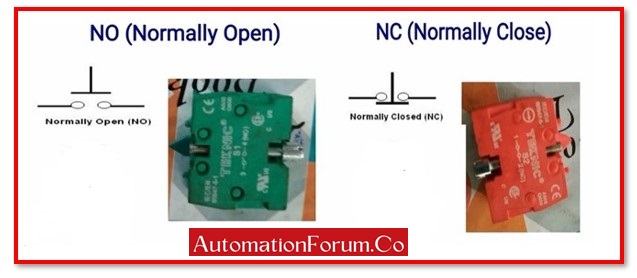Logic is constructed based on the open or closed state of switches, sensors, or relays in every control circuit and automation system. Thus, understanding the NO/NC notion is essential. The phrases “normally open” (NO) and “normally closed” (NC) are used to describe the states that switches, sensors, or relay contacts are in when their coils are not stimulated. It is the core of process automation.
How does NO contact work?
The contact that remains open until a specific requirement is completed is known as a NO contact or a normally open contact. Consider a limit switch as an illustration. A limit switch must contain at least one NO contact. The limit switch’s NO contact stays open until the actuator is depressed. As soon as the actuator is depressed, the contact closes and begins to conduct. When it comes to proximity switches, NO contacts stay open until they detect an disrupt, and when it comes to pressure switches, the contact stays open until the predetermined pressure threshold is exceeded.

How does NC contact work?
A NC contact, also known as a normally closed contact, functions exactly the same way as a NO contact. It stays closed until a specific requirement is accomplished. In this instance, an example of limit switch action. When a limit switch’s actuator is pressed, its NC contact, which is employed in a circuit, interrupts the circuit or current flow. Similar to this, a relay’s contacts are always closed unless its coil is energised.

What use do the NO and NC two contacts on a push button switch serve?
When you depress the NC contact, the circuit is connected.
A maintenance relay will often be present in this circuit to maintain the circuit’s connection. In this manner, the loop is kept electrified through the maintenance relay when the push button switch is released, enabling the system to function normally. prior to the arrival of the termination signal, such as the close button or emergency stop.
Push button switches often include two contacts of NO and NC because some applications require the use of NO contacts while others require the use of NC contacts. For example, the start button requires the use of NO contacts while the stop button requires the use of NC contacts (constitute one NO contact, one NC contact). The switch differs from the lighting panel switch in that the contact returns to its initial condition as soon as the button is released. There is no defence mechanism. Circuit breakers with load and short circuit protection are used in the lighting panel switch. It will stay closed till it pulls it open if there is no malfunction.

How to determine whether a Contact is Normally Open or Closed?
The easiest way to recognise contacts is by their marking with the letters NO or NC, which are used on most switches and buttons. On the side of the component, manufacturers will occasionally place a little graphic showing the contact layout. This information is shown on a large number of contacts that are used for switches.
If the contacts are not marked, then should test them using a testing tool, such as a multimeter. In the absence of electricity and without being activated, a usually open contact will be open. When there is no power supply connected to a contact, it will be closed normally.
Difference Between NO and NC Contact:
NO and NC contacts are distinguished by the terminal:
Generally, the terminal itself can be used to distinguish between the NO and NC contacts. In general, the NO contact is at the lower end and the NC contact is at the top.
NO and NC Contact Switch Current:
The switch’s “normal” setting is when it is not being operated.
In a typically open switch, this would imply that the switch is open when it is not in use, meaning that no current can pass through it, or that the switch is off when it is not being pressed.
A typically closed switch allows current to flow through it continuously unless you decide to press the button, in which case it will turn off. A normally closed switch is closed when it is not being used.

NO and NC connections can be distinguished by terminal colour:
The colour of the terminal can be used to identify some push button switches. To prevent operational errors, do this the button caps are typically constructed of various colours. Red (or pink) indicates NC contact whereas green (or blue) indicates NO contact.
Measure the NO and NC Connections:
When a resistance value exists, it is NC contact, and it is typically very small—between 0.2 – 1. It is NO contact if the resistance value is substantially high.
Application Difference Between NO and NC Contact
NO switches Application:
- Reset switch
- Toggle switch
- Footswitches
NC switches Application:
- Normally closed relays





